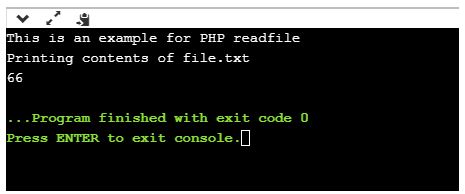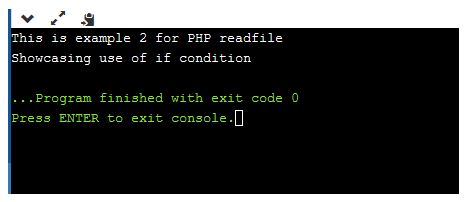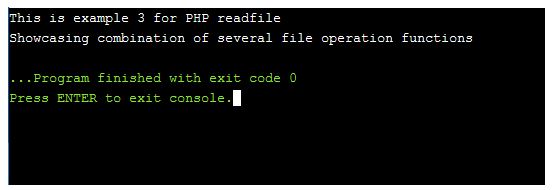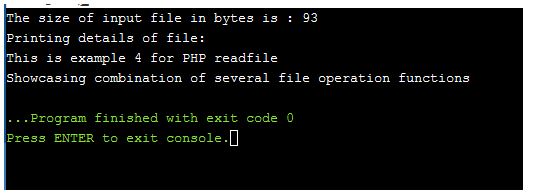Updated March 24, 2023
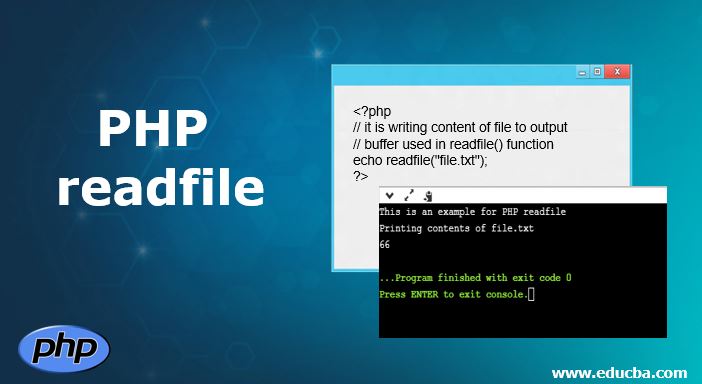
Introduction to PHP readfile
PHP readfile is basically an inbuilt function in the PHP library used for reading a file and then writing it to an output buffer.
Syntax:
readfile ( string $file_name [, boolean $path = FALSE [, resource $context ]] ) : intThe parameters being used in the syntax:
- filename: It is a mandatory field where we provide the name of the file to be read.
- path: This is an optional parameter and is a boolean value that can be set to either true or false if the file needs to be searched in the provided path.
- context: This is also an optional field which is used to specify the context of the file handle. Basically a context is a collection of objects having an ability to change the behavior of that stream. It returns the number of bytes which is read from the file if success and returns false if failed to read.
Methods of PHP readfile
Apart from readfile() function, below are some of the other functions that can be used for performing various kinds of operations on the files.
1. file()
This function is also used to read a file and it reads the complete file into an array.
Syntax:
file ( string $file_name [, int $flag = 0 [, resource $context ]] ) : arraywhere file_name is the path to the file to be read. Flags are the optional fields which can be chosen from the below constants:
- FILE_USE_INCLUDE_PATH: To search for the respective file in the given path.
- FILE_IGNORE_NEW_LINES: To omit a new line at the last of each array element.
- FILE_SKIP_EMPTY_LINES: To skip empty lines.
It returns the file present in the array upon success and false upon failure.
2. fopen()
This function can be used to open both a file and a URL.
fopen ( string $file_name , string $mode [, bool $use_include_path = FALSE [, resource $context ]] ) : resource- where if file_name is a URL then PHP searches a protocol handler (also called as a wrapper) for it. The PHP will issue a notice to help track possible problems in the script and then continue considering it as a normal regular file_name.
- Suppose if the file_name is a local file then PHP tries to open the same stream on that file. The file will be accessible by PHP only if required permissions are granted for its access.
- And suppose the given file_name is a registered protocol and if that one is registered as a network URL then the first PHP ensures that the allow_url_fopen is enabled. It will issue a warning and fail if it is disabled.
Mode: This parameter mentions the kind of access required to be given to the stream.’ Below are few important modes:
- r – read mode only
- r+ – both read and write only
- w – write mode only
It returns a file pointer resource if success and false on failure.
3. fread()
This function is used for binary-safe file read.
Syntax:
fread ( resource $handle , int $length ) : stringwhere the handle is used for referencing the file pointer.
The file is read until it reaches one of the below conditions: length in bytes must have been read, EOF is reached, socket timeout occurs. fgets(), fscanf(), ftell(), fwrite(), fopen(), fsockopen() are a few other functions used for file operations in PHP.
Examples of PHP readfile
Given below are the examples of PHP readfile:
Example #1
Code:
<?php
// it is writing content of file to output
// buffer used in readfile() function
echo readfile("file.txt");
?>Output:
This shows a basic example to read a file existing in the local path. Make sure that the filename being specified in the parameter of readfile() function is created and the content to be read is present inside the file. When the readfile() function is used it reads the content of the file and prints in the output.
Example #2
Code:
<?php
/ file contents written on output
// buffer by readfile() function
$file = @readfile("file.txt");
if (!$file)
{
print "File could not be opened";
}
?>Output:
The previous output was a simple example without any conditions. In this example, let us see how to read and display the output of a file by using certain conditions. We are using if statement to print suppose the file is not present.
Example #3
Code:
<?php
$file_name = "file.txt";
$fh = fopen($file_name, 'r');
$data = fread($fh, filesize($file_name));
fclose($fh);
echo $data;
?>Output:
In this example, we are combining the use of multiple file read functions. As in all the above examples, first, we are giving the file name which needs to be read from. Then the mode of operation, ‘r’ is given to them indicating it can only be read. filesize() function takes the filename and returns the size of the file along with its data and assigns it to $data variable. By using fclose() function we are closing that file. Finally, the data is printed as output.
Example #4
Code:
<?php
$file_name = "file.txt";
$file = fopen( $file_name , "r" );
if( $file == false ) {
echo ( "Error in opening file" );
exit();
}
$size = filesize( $file_name );
$filetext = fread( $file, $size);
fclose( $file );
echo ( "The size of input file in bytes is : $size\n" );
echo ("Printing details of file:\n");
echo ( $filetext );
?>Output:
Before running the code, make sure that the file to be read file.txt is created in the local file path. In this example first, we are declaring the file name to be read and opening that with the function fopen(). Suppose the file does not exist, using if condition we are throwing an error message. Finally, we are printing the file size and the content present in the input file.
Conclusion
As seen from all the above examples, readfile() is one of the main functions of PHP used for reading the file name specified in this function. Apart from readfile() we have covered a few other file operations which perform similar actions such as fopen, file, fread, fgets, fgetss, ftell, etc. A combination of all of these are basically used in accessing and performing operations on the input file.
Recommended Articles
This is a guide to PHP readfile. Here we discuss the introduction, methods, and examples of php readfile along with code implementations. You may also have a look at the following articles to learn more –
